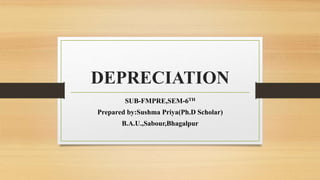
DEPRECIATION.pptx
- 1. DEPRECIATION SUB-FMPRE,SEM-6TH Prepared by:Sushma Priya(Ph.D Scholar) B.A.U.,Sabour,Bhagalpur
- 2. CONCEPT OF DEPRECIATION • Depreciation is defined as the decline in the value of asset due to usage,accidental damage and time obsolescence. • When an assets is used,it undergoes wear and tear(degradation of an assets from ongoing usage) and hence the reduction in the value of assets which is termed as depreciation. • Even if the asset is not used its value declines,over a period of time,because the asset may became outdates or outmodelled or go out of fashion.This is known as time depreciation. • Weather is also an important factor that causes decline in the value due to corrosion. • To compute depreciation we need information on original cost of assets,useful life and junk value.
- 3. Important definition • Useful life:It is the number of years that an asset provides its services to the farm business.Useful life varies with the types of asset. • Junk value/Salvage value:It is the value of assets at the end of its useful life. • Book value:It is the value based on original cost or according to its balance sheet.
- 4. Methods of computation of Depreciation 1.Straight line method 2.Diminishing Balance Method 3.Sum of the Years Digits Method 4.Annual Revaluation Method
- 5. 1.Straight line method • This method is applied under the assumption of constant use of assets over the years.This is the most popular and widely used method in computing depreciation because of the simplicity in calculation.Following equation is used to compute depreciation: • Annual amount of depreciation=Original cost of asset-junk value/Useful life of the asset • Example: Original cost of a plough=Rs.500 Junk value=50 Useful life=5 Yr. Annual cost of depreciation=?
- 6. 2.Diminishing Balance Method • This method assumes varying rates of use of asset,year after year.The following equation is used to compute annual amount of depreciation. • Annual amount of depreciation=(Book value of asset)xR Where: R=It is the rate of depreciation to be charged over the useful life of the asset and is computed by dividing 100 per cent with useful life. Example: Origianl cost of a plough=Rs.500 Useful life=5 year R=100/5=20%
- 7. Computation of depreciation by Diminishing Balance Method Year Rate of depreciation( %) Amount of depreciation(Rs.) Book Value(Rs.)=Total value of asset or original cost- depreciation 1. 20 500x20/100=100 500-100=400 2. 20 400x20/100=80 320 3. 20 320x20/100=64 256 4. 20 256x20/100 204.80 5. 20 204.80*20/100 163.84 Total value 500-163.84=336.16 We should note that higher amount of depreciation is charged in first year and less in subsequent years.This because the asset is put to intensive use when it is brand new and therefore wear and tear is also rapid.When asset becomes older its use gradually reduces as a result wear and tear too is less.
- 8. 3.Sum of the Years Digits Method • This method also assume that an asset is put to varying rates of use year after year.Annual amount of depreciation is calculated from the following formula: • Annual amount of depreciation= Original cost of asset-junk valuexRemaining year of useful life/Sum of digits from one through useful life Note:Sum of the digits can be computed quickly from the equation=n(n+1)/2
- 9. Example: Origianl cost of a plough=Rs.500 Junk value=Rs.50 Useful life=5 years Sum of the digits of useful life=5(5+1)/2=5x3=15 Sum of the digit of useful life can also be computed by adding all the digit from 1 to useful life. 5+4+3+2+1=15
- 10. Computation of depreciation by Sum of the Years Digits Method Year Rate(Remainin g yr of useful life/sum of year digit) Amount (Rs.) Book value(Rs.) 1. 5/15 (500-50)x5/15=150 350 2. 4/15 (500-50)x4/15=120 230 3. 3/15 (500-50)x3/15=90 140 4. 2/15 (500-50)x2/15=60 80 5. 1/15 (500-50)x1/15=30 50 Total value=500-50=450 The annual amount of depreciation is declining from Rs.150 in the first year to Rs.30 in the last year reason is already presented in diminishing balance method which holds true.
- 11. 4.Annual Revaluation Method • As the name indicates,in this method the asset is revalued every year.More specifically,the value of asset is estimated at the beginning as well at the end of the year. • The difference arrived indicates the depreciation or appreciation of the assets. • In respect of livestock,as the value increases in the initial years this method rightly catches up the amount of appreciation.However, the application of this method to all the assets poses a problem because,it is difficult to get the actual market prices for the assets of varying wear and tear.